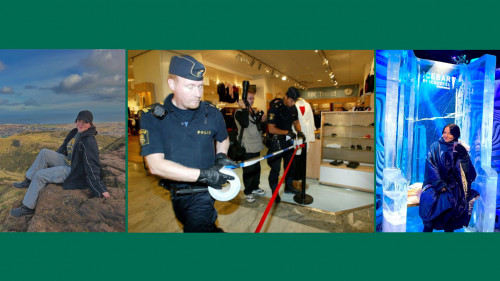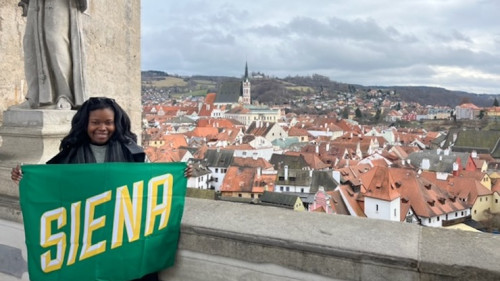
A joint course on trauma resilience was capped off with a trip to Poland, where students visited sites that manifested both heaven and hell on earth.
Dmitry Burshteyn Ph.D., associate professor of psychology, and Jami Cotler, Ph.D., associate professor of computer science, joined forces to offer Adaptability, Accessibility, and Resilience at War/Conflict Times (PSYC490) and Trauma Informed UX Design (CSIS200) this spring semester. They and their 22 students traveled to Poland May 22-30, where they spoke with refugees from the Ukrainian conflict, met with an international aid organization, and bore witness at the infamous Nazi death camp Auschwitz-Birkenau.
In Burshteyn’s psychology class, the focus was on resilience, empathy, and providing social support to war victims. Students began by exploring techniques and practices aimed at managing stress in times of uncertainty. They then did a deeper dive into understanding the complex nature of trauma in war zones and other conflict environments. Cotler’s computer science students examined how user experience (UX) design can be informed by and respond to trauma, especially war-related trauma. They engaged in a hands-on website design project for a refugee center using UX solutions that are sensitive to traumatic experiences and promote healing and resilience.
The immersive trip to Poland was both educational and practical: in addition to touring historical, cultural and religious sites, they delivered school supplies, candy and good cheer to mothers and children at the Wolno Nam refugee center outside of Krakow, which houses those who have fled the Ukrainian conflict. (It was Wolno Nam for whom the Saints did the website design project.) They had meetings with social workers at HIAS (formerly the Hebrew Immigrant Aid Society) in Warsaw to discuss how Ukrainian war refugees have been absorbed into Polish society over the last two years. The parks, palaces and cathedrals of Krakow and Wroclaw were also on the itinerary.
At Wolno Nam, the students listened to a young mother who wept as she shared her heart-wrenching experience about fleeing her homeland. Burshteyn, himself a native of Ukraine, interpreted for her.
“Our students not only listened to how the war affected her and her family, but they also critically processed and asked questions about her social support and coping strategies based on what they learned in the course,” he said. “They witnessed her resilience and determination despite the overwhelming challenges she faced. I was proud to see them offer empathetic support and valuable insights on how she might reevaluate her life and goals to address some of the trauma, helping her move forward and continue her coping efforts.”
Hailey Memery ’24 said she was “extremely touched” by the children at Wolno Nam.
“Knowing what all of the children had likely been through and being able to make them smile and laugh was something I genuinely don’t think I’ll ever be able to forget,” Memery said. “Personally, the experience of interacting with such individuals made me realize all the more that this population needs our help. I would be honored to assist and work with them in the future.”
Samantha Murphy ’24 added, “Being a part of this experience is something I will cherish forever.
Immersing myself in this new culture, and creating special bonds, has given me lifelong memories.”
Cotler explained that “empathy lies at the heart” of the class and the trip.
“The students immersed themselves in the real-life stories of individuals touched by war and trauma, examining both modern-day Ukraine and historical events like the Holocaust,” she said. “These experiences provided invaluable insights and also fostered a profound empathy for the users of the website they designed for the Wolno Nam refugee center, while also nurturing their own personal resilience.”
The Saints toured the capital city of Warsaw, an exemplar of resilience that was entirely rebuilt after being bombed to rubble in World War II. Historic neighborhoods and palaces were reconstructed according to old photos and records; they now stand near the glass-and-steel skyscrapers that are a modern-day testament to Warsaw’s role as an Eastern European financial center.
Most intense was the tour of Auschwitz-Birkenau, where more than a million deportees were systematically killed or worked to death by the Nazis.
“Auschwitz was a grim reminder of the depths of human cruelty, while the trip to the refugee camp in Walno Nam highlighted the ongoing struggles of displaced individuals seeking safety and grace,” said Spencer Caramanna ‘24. “Together, these experiences underscored the importance of remembering history and extending compassion to those in need today.”
Gus Byrne ’26 said meeting the Ukrainian refugees and seeing Auschwitz in person were both “very powerful.”
“You hear about the refugees in class and on the news, and you learn about history in books, but it’s so different to actually be in the place where these events happened,” Byrne said. “It all becomes so much more real and horrific.”

